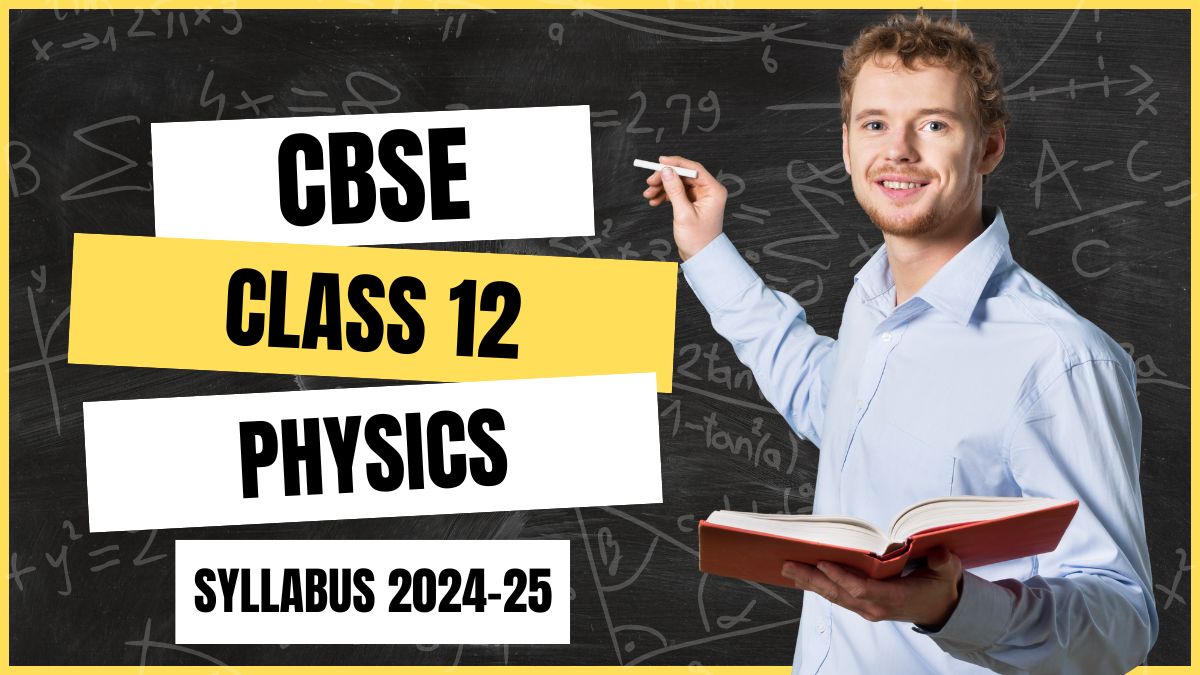CBSE Class 12 Physics Syllabus 2025-26
In addition to theory, the syllabus emphasizes practical work, which is crucial for developing a deeper understanding of physical concepts. It includes a list of experiments, activities, and investigatory projects that students must complete during the academic year, ensuring a balance between theoretical knowledge and hands-on experience. The official syllabus PDF, available on the CBSE website, provides all necessary information, including evaluation schemes and guidelines for practicals, making it an indispensable resource for effective preparation.
Class 12 Physics Unit-Wise Syllabus
| Unit No. | Unit Name | No. of Periods | Marks |
|---|---|---|---|
| I | Electrostatics | 26 | 16 |
| II | Current Electricity | 18 | |
| III | Magnetic Effects of Current and Magnetism | 25 | 17 |
| IV | Electromagnetic Induction and Alternating Currents | 24 | |
| V | Electromagnetic Waves | 04 | 18 |
| VI | Optics | 30 | |
| VII | Dual Nature of Radiation and Matter | 08 | 12 |
| VIII | Atoms and Nuclei | 15 | |
| IX | Electronic Devices | 10 | 07 |
| Total | 160 | 70 |
CBSE Class 12 Physics Syllabus 2025-26 in Detail
The full CBSE Class 12 Physics Syllabus 2025-26 is given below. Check the whole syllabus with names of the important topics
Unit I: Electrostatics (26 Periods)
- Chapter–1: Electric Charges and Fields
- Electric charges, conservation of charge, Coulomb’s law.
- Electric field, field due to a point charge, electric field lines.
- Electric dipole, field due to a dipole, torque on a dipole in a uniform electric field.
- Electric flux, Gauss’s theorem applications: infinitely long wire, charged plane sheet, spherical shell.
- Chapter–2: Electrostatic Potential and Capacitance
- Electric potential, potential difference, potential due to a point charge, dipole, system of charges.
- Equipotential surfaces, electrical potential energy.
- Conductors and insulators, dielectrics and polarization, capacitors, combination of capacitors.
- Energy stored in a capacitor.
Unit II: Current Electricity (18 Periods)
- Chapter–3: Current Electricity
- Electric current, drift velocity, mobility, Ohm’s law, V-I characteristics.
- Electrical resistivity, conductivity, temperature dependence of resistance.
- Internal resistance of a cell, combination of cells, Kirchhoff’s rules, Wheatstone bridge.
Unit III: Magnetic Effects of Current and Magnetism (25 Periods)
- Chapter–4: Moving Charges and Magnetism
- Magnetic field, Oersted’s experiment, Biot-Savart law, Ampere’s law.
- Force on moving charges in magnetic/electric fields, force on current-carrying conductors, torque.
- Current loop as a magnetic dipole, moving coil galvanometer.
- Chapter–5: Magnetism and Matter
- Bar magnet, magnetic dipole, magnetic properties of materials (para-, dia-, and ferromagnetic substances).
- Magnetization of materials, temperature effect on magnetic properties.
Unit IV: Electromagnetic Induction and Alternating Currents (24 Periods)
- Chapter–6: Electromagnetic Induction
- Faraday’s laws, induced EMF, Lenz’s Law, self and mutual induction.
- Chapter–7: Alternating Current
- Alternating currents, peak/RMS values, reactance, impedance, LCR series circuit.
- AC generator, transformer.
Unit V: Electromagnetic Waves (04 Periods)
- Chapter–8: Electromagnetic Waves
- Displacement current, characteristics of electromagnetic waves.
- Electromagnetic spectrum: radio waves, microwaves, infrared, visible, ultraviolet, X-rays, gamma rays, and uses.
Unit VI: Optics (30 Periods)
- Chapter–9: Ray Optics and Optical Instruments
- Reflection, refraction, mirror/lens formulas, magnification, power, optical instruments.
- Chapter–10: Wave Optics
- Wavefront, Huygen’s principle, reflection/refraction using wavefronts.
- Interference, Young’s experiment, diffraction.
Unit VII: Dual Nature of Radiation and Matter (08 Periods)
- Chapter–11: Dual Nature of Radiation and Matter
- Photoelectric effect, Einstein’s photoelectric equation, particle nature of light.
- Matter waves, de-Broglie relation.
Unit VIII: Atoms and Nuclei (15 Periods)
- Chapter–12: Atoms
- Rutherford’s model, Bohr model, hydrogen line spectra.
- Chapter–13: Nuclei
- Composition, nuclear force, mass-energy relation, nuclear fission/fusion.
Unit IX: Electronic Devices (10 Periods)
- Chapter–14: Semiconductor Electronics: Materials, Devices, and Simple Circuits
- Energy bands, intrinsic/extrinsic semiconductors, p-n junction diode, applications.
CBSE Class 12 Maths Syllabus 2025-26 PDF Download
The CBSE Class 12 Maths syllabus for 2025-26 can be downloaded from the official CBSE website. This PDF contains detailed topics for each unit, the number of periods for each chapter, and marks distribution. It is important for students to refer to this syllabus to plan their studies and ensure they cover all the required content effectively for the exam.
PHYSICS Subject Code – 042 Class XI-XII (2025-26)-Click Here To Download PDF
Class 12 Physics Practicals and Evaluation
Practicals
- Total Periods: 60
Practical Record Requirements
- Record of at least 8 Experiments (4 from each section).
- Record of at least 6 Activities (3 from each section).
- Report of the project.
Evaluation Scheme
| Component | Max Marks | Time |
|---|---|---|
| Two experiments (one from each section) | 7 + 7 | 3 Hours |
| Practical record (experiments/activities) | 5 | |
| One activity (any section) | 3 | |
| Investigatory project | 3 | |
| Viva (experiments, activities, project) | 5 | |
| Total | 30 |
Section-A: Experiments and Activities
Experiments
- Determine resistivity of wires using potential difference vs current graph.
- Find resistance using metre bridge (series/parallel combinations).
- Determine resistance of a galvanometer (half-deflection method).
- Convert a galvanometer into a voltmeter/ammeter and verify.
- Find the frequency of AC mains using a sonometer.
Activities
- Measure resistance/impedance of an inductor.
- Measure resistance, voltage, current, and circuit continuity using a multimeter.
- Assemble a household circuit with bulbs, switches, fuse, and power source.
- Study variation in potential drop with length of a wire for steady current.
- Draw and correct given open circuit diagrams.
Section-B: Experiments and Activities
Experiments
- Find focal length of concave mirror, convex lens, or convex mirror.
- Determine angle of minimum deviation for a prism.
- Find refractive index using traveling microscope, convex lens, or concave mirror.
Activities
- Identify electronic components (diode, LED, resistor, capacitor).
- Observe refraction, diffraction, and image formation using lenses/mirrors.
- Obtain lens combinations with specified focal length.
Suggested Investigatory Projects
- Study factors affecting internal resistance/EMF of a cell.
- Investigate current variation in circuits with LDR.
- Find refractive indices of liquids using lenses and mirrors.
- Investigate voltage ratio relation in transformer coils.
- Estimate the charge on Styrofoam balls using Coulomb’s law.
- Study self-inductance of a coil in series with resistors.
- Study the earth’s magnetic field using a compass.
Related Articles:
FAQs
1. What is the latest CBSE Class 12 Physics syllabus for 2025-26?
Answer:
The CBSE has released the Physics syllabus for Class XII for the academic session 2025-26.
The syllabus consists of nine theory units plus internal practical work.
Some of the major units/topics included are:
-
Electrostatics (Electric Charges & Fields; Electrostatic Potential & Capacitance)
-
Current Electricity
-
Magnetic Effects of Current & Magnetism
-
Electromagnetic Induction & Alternating Currents
-
Electromagnetic Waves
-
Optics (Ray Optics & Optical Instruments, Wave Optics)
-
Dual Nature of Radiation & Matter
-
Atoms & Nuclei
-
Electronic Devices (Semiconductor Electronics and Simple Circuits)
In addition, internal assessment / practical experiments are part of the evaluation.
2. How many marks / what is the weightage for theory, practical, etc.?
Answer:
-
The total marks for Physics are 100 (Theory + Practical / Internal).
-
Theory paper is of 70 marks.
-
Practical / internal work is 30 marks.
Note: Within theory, different units have varying weightages; more important / heavier units will be tested more.
3. How many experiments / practicals are there in the syllabus?
Answer:
The Physics syllabus includes a list of prescribed experiments in the practical/internal component.
(Exact number may vary depending on the school/instructor, but CBSE typically prescribes 6 experiments in one section and 9 experiments in another, for older syllabi.
Additionally, there may be activities or projects as part of internal assessment.
If you like, I can send you the full list of experiments for 2025-26.
4. What kind of questions are asked in the Physics theory paper?
Answer:
Question types typically include:
-
Very short / objective type (MCQs, fill in the blanks, match the following)
-
Short answer questions (1–2 marks)
-
Long / numerical problems (3–5 marks)
-
Derivation / explanation / conceptual questions
-
Application-based questions requiring understanding of concepts
Also, the CBSE emphasizes competency-based questions and application of concepts, not just rote memorization.
5. Are there any major changes in the 2025-26 syllabus compared to earlier years?
Answer:
From what’s available, the 2025-26 syllabus is largely consistent with the current pattern, with full syllabus reinstated.
The CBSE emphasizes deeper conceptual understanding, use of SI units, correct nomenclature, and integrating application-based / higher-order thinking questions.
If you tell me which past year you are comparing with (2024, 2023, etc.), I can point out differences.
6. How should one prepare for Class 12 Physics exam under this syllabus?
Answer / Tips:
-
Know the syllabus fully — units, chapters, and sub-topics; so you don’t miss topics.
-
Focus on conceptual clarity rather than rote memory, especially for derivations and formulas.
-
Practice numerical problems — many questions will require working with formulas (Electrostatics, Current Electricity, Optics, etc.).
-
Solve past year questions / sample papers — helps understand pattern, difficulty, time management.
-
Revise regularly — physics has many formulas; make concise notes / formula sheets.
-
Do all prescribed experiments / practical work thoroughly — experiments often have internal marks, and also help in conceptual understanding.
-
Pay attention to units, SI prefixes, significant figures — these details often come up in evaluation.
-
Attempt all parts of paper — leaving too many blanks can lose marks; even short questions should be answered.
-
Time management — allocate time to different sections; don’t get stuck on a question for too long.
7. Where can I download the official CBSE Physics syllabus PDF?
Answer:
You can download it from the CBSE Academic / Curriculum section of the CBSE official website.
Also, Syllabus4u gives the same PDF. For example, the “PHYSICS Subject Code – 042 Class XI-XII (2025-26)” PDF is available.
8. Which units or topics are considered more “high weightage” or more important for exams?
Answer:
While every unit has importance, some units tend to carry more weight in exams based on past trends:
-
Electrostatics
-
Magnetic Effects / Magnetism
-
Current Electricity / Circuits
-
Optics (especially ray optics and wave optics)
-
Electromagnetic Induction / Alternating Current
Still, the CBSE wants a balanced coverage, so neglecting any unit would be risky.
9. Are derivations required? Which ones?
Answer:
Yes, derivations are an important part of Physics. Students are usually expected to derive key formulas (e.g. from fundamental laws) in many chapters (Electrostatics, Current, Optics, etc.).
However, CBSE may specify which derivations are “essential” in the teacher resource / guidelines. In some cases, only qualitative treatment is needed (not full derivation) for certain topics.

